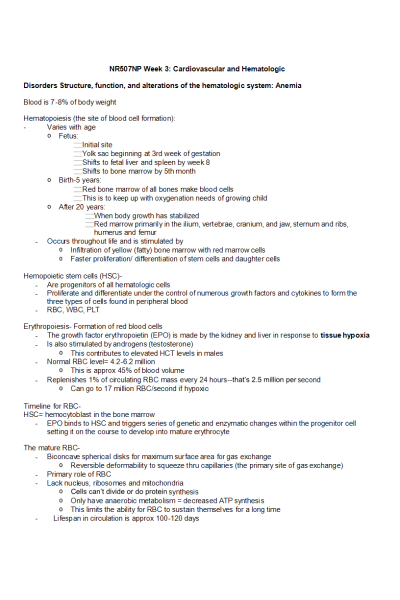NR 507 Week 3 Readings- Notes; Cardiovascular and Hematological Disorders
-
$10.00
| Institution | NR 507 Advanced Pathophysiology |
| Contributor | Mireille |
Blood is 7-8% of body weight
Hematopoiesis (the site of blood cell formation):
- Varies with age
- Fetus:
- Initial site
- Yolk sac beginning at 3rd week of gestation
- Shifts to fetal liver and spleen by week 8
- Shifts to bone marrow by 5th month
- Birth-5 years:
- Red bone marrow of all bones make blood cells
- This is to keep up with oxygenation needs of growing child
- After 20 years:
- When body growth has stabilized
- Red marrow primarily in the ilium, vertebrae, cranium, and jaw, sternum and ribs, humerus and femur
- Occurs throughout life and is stimulated by
- Infiltration of yellow (fatty) bone marrow with red marrow cells
- Faster proliferation/ differentiation of stem cells and daughter cells
- Fetus:
Hemopoietic stem cells (HSC)-
- Are progenitors of all hematologic cells
- Proliferate and differentiate under the control of numerous growth factors and cytokines to form the three types of cells found in peripheral blood
- RBC, WBC, PLT
Erythropoiesis- Formation of red blood cells
- The growth factor erythropoietin (EPO) is made by the kidney and liver in response to tissue hypoxia
- Is also stimulated by androgens (testosterone)
o This contributes to elevated HCT levels in males
- Normal RBC level= 4.2-6.2 million
o This is approx 45% of blood volume
- Replenishes 1% of circulating RBC mass every 24 hours--that’s 2.5 million per second
o Can go to 17 million RBC/second if hypoxic
Timeline for RBC-
HSC= hemocytoblast in the bone marrow
- EPO binds to HSC and triggers series of genetic and enzymatic changes within the progenitor cell setting it on the course to develop into mature erythrocyte
The mature RBC-
- Biconcave spherical disks for maximum surface area for gas exchange
o Reversible deformability to squeeze thru capillaries (the primary site of gas exchange)
- Primary role of RBC
- Lack nucleus, ribosomes and mitochondria
- Cells can’t divide or do protein synthesis
- Only have anaerobic metabolism = decreased ATP synthesis
- This limits the ability for RBC to sustain themselves for a long time
- Lifespan in circulation is approx 100-120 days
o But will have traveled thousands of miles through vascular system................ Continue
| Instituition / Term | |
| Term | Year 2022 |
| Institution | NR 507 Advanced Pathophysiology |
| Contributor | Mireille |





























